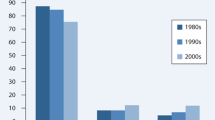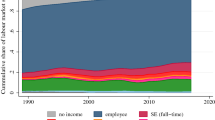Abstract
We consider the exit routes of older employees out of employment around retirement age. Our administrative data cover weekly information about the Danish population from 2004 to 2016 and 397 variables from 16 linked administrative registers. We use a flexible dependent competing risks quantile regression model to identify how early and late retirement transitions are related to the information in various registers. Our model selection is guided by machine learning methods, in particular statistical regularization. We use the (adaptive) group bridge to identify the relevant administrative registers and variables in heterogeneous and high-dimensional data, while maintaining the oracle property. By applying state-of-the-art statistical methods, we obtain detailed insights into conditional distributions of transition times into the main pension programs in Denmark.






Similar content being viewed by others
References
Ahn KW, Kim S. Variable selection with group structure in competing risks quantile regression. Stat Med. 2018;37(9):1577–86.
Amilon A, Nielsen TH. How does the option to defer pension payments affect the labour supply of older workers in Denmark? working and ageing: emerging theories and empirical perspectives, 190–209. European Centre for the Development of Vocational Training, 2010.
An M, Christensen B, Gupta N. Multivariate mixed proportional hazard modelling of the joint retirement of married couples. J Appl Econom. 2004;19(6):687–704.
Barslund M. Extending working lives: the case of Denmark. CEPS Working Document, No. 404. Available at SSRN: https://ssrn.com/abstract=2577739, 2015.
Belloni A, Chernozhukov V. ℓ1-penalized quantile regression in high-dimensional sparse models. Ann Stat. 2011;39(1):82–130.
Belloni A, Chernozhukov V. Least squares after model selection in high-dimensional sparse models. Bernoulli. 2013;19(2):521–47.
Bingley, Lanot. Public pension programmes and the retirement of married couples in Denmark. J Public Econ. 2007;91(10):1878–901.
Bingley P, Gupta ND, Pedersen PJ. Disability programs, health, and retirement in Denmark since 1960. NBER Chapters, in: Social Security Programs and Retirement around the World: Historical Trends in Mortality and Health, Employment, and Disability Insurance Participation and Reforms, 217–249 National Bureau of Economic Research, Inc., 2012.
Bingley P, Gupta ND, Jørgensen M, Pedersen PJ. Health, disability insurance, and retirement in Denmark. In: Wise DA, editor. Social security programs and retirement around the world: disability insurance programs and retirement. Chicago: University of Chicago Press; 2016.
Borger.dk. Kan jeg få efterløn? 2020. https://www.borger.dk/pension-og-efterloen/Efterloen-fleksydelse-delpension/Efterloen/Efterloen-hvis-du-er-foedt-foer-1956/Kan-jeg-faa-efterloen.
Chatterjee A, Lahiri SN. Bootstrapping Lasso estimators. J Am Stat Assoc. 2011;106(494):608–25.
Chatterjee A, Lahiri SN. Rates of convergence of the adaptive LASSO estimators to the oracle distribution and higher order refinements by the bootstrap. Ann Stat. 2013;41(3):1232–59.
Chen JE, Tien JJ. Debiased/double machine learning for instrumental variable quantile regressions. arXiv, 2019.
Chernozhukov V, Chetverikov D, Demirer M, Duflo E, Hansen C, Newey W, Robins J. Double/debiased machine learning for treatment and structural parameters. Econom J. 2018;21(1):C1–68.
Christensen B, Kallestrup-Lamb M. The impact of health changes on labor supply: evidence from merged data on individual objective medical diagnosis codes and early retirement behavior. Health Econ. 2012;21(Supp1):56–100.
Cox DR. Renewal theory, London, 1962.
Danø M, Ejrnæs M, Ejrnæs L. Do single women value early retirement more than single men? Labour Econ. 2005;12(1):47–71.
Dlugosz S, Peng L, Li R. cmprskQR: analysis of competing risks using quantile regressions. R package version 0.9.2. https://CRAN.R-project.org/package=cmprskQR, 2019.
Dlugosz S, Lo S, Wilke R. Competing risks quantile regression at work: in-depth exploration of the role of public child support for the duration of maternity leave. J Appl Stat. 2017;44(1):109–22.
Duval R. The retirement effects of old-age pension and early retirement schemes in OECD Countries. OECD Economics DepartmentWorking Paper 370, OECD, 2003.
Emura T, Shih JH, Ha ID, Wilke RA Comparison of the marginal hazard model and the subdistribution hazard model for competing risks under an assumed copula. Stat Methods Med Res 2019;1–21.
Fermanian J. Nonparametric estimation of competing risks models with covariates. J Multivar Anal. 2003;85(1):156–91.
Filges T, Larsen M, Pedersen PJ. Retirement: Does individual unemployment matter? Evidence from Danish Panel Data 1980–2009. IZA Discussion Paper, No. 6538, Institute for the Study of Labor (IZA), 2012.
Fine JP, Gray RJ. A proportional hazards model for the subdistribution of a competing risk. J Am Stat Assoc. 1999;94(446):496–509.
Fitzenberger B, Wilke RA. New insights into unemployment duration and post unemployment earnings in Germany. Oxford Bull Econ Stat. 2010a;72(6):794–826.
Fitzenberger B, Wilke R. Unemployment durations in West Germany before and after the reform of the unemployment compensation system during the 1980s. German Econ Rev. 2010b;11(3):336–66.
Friedman J, Hastie T, Tibshirani R. Regularization paths for generalized linear models via coordinate descent. J Stat Softw. 2010;33(1):1–22.
Fu WJ. Penalized regressions: the bridge versus the Lasso. J Comput Graph Stat. 1998;7(3):397–416.
Gørtz M. Early retirement in the day-care sector: the role of working conditions and health. Eur J Ageing. 2012;9(3):187–98.
Gruber J, Wise D. Social security and retirement: an international comparison. Am Econ Rev. 1998;88(2):158–63.
Hastie T, Tibshirani R, Wainwright M. Statistical learning with sparsity: the Lasso and generalizations. Boca Raton: Chapman and Hall/CRC; 2015.
Heckman J, Honoré B. The identifiability of the competing risks model. Biometrika. 1989;76(2):325–30.
Hoerl Arthur E. Application of ridge analysis to regression problems. Chem Eng Prog. 1962;58(3):54–9.
Huang J, Breheny P, Ma S. A selective review of group selection in high-dimensional models. Stat Sci. 2012;27(4):481–99.
Huang J, Ma S, Xie H, Zhang C. A group bridge approach for variable selection. Biometrika. 2009;96(2):339–55.
Kallestrup-Lamb M, Kock A, Kristensen J. Lassoing the determinants of retirement. Econom Rev. 2016;35(8–10):1–40.
Koenker R, Bassett G. Regression quantiles. Econometrica. 1978;46(1):33–50.
Koenker R, Bilias Y. Quantile regression for duration data: a reappraisal of the Pennsylvania reemployment bonus experiments. Empir Econ. 2001;26(1):199–220.
Koenker R, Chernozhukov V, He X, Peng L, editors. Handbook of quantile regression. Boca Raton: Chapman and Hall/CRC Press; 2017.
Koenker R, Geling O. Reappraising medfly longevity: a quantile regression survival analysis. J Am Stat Assoc. 2001;96(454):458–68.
Koenker R. quantreg: quantile regression. R package version 5.33. https://CRAN.R-project.org/package=quantreg, 2017.
Kyyrä T, Wilke R. Reduction in the long-term unemployment of the elderly: a success story from Finland. J Eur Econ Assoc. 2007;5(1):154–82.
Larsen M, Pedersen JP. Pathways to Early Retirement in Denmark, 1984–2000. IZA Discussion Paper, No. 1575, Institute for the Study of Labor (IZA), 2005.
Larsen M, Pedersen P. To work, to retire: or both? Labor market activity after 60. IZA J Eur Labor Stud. 2013;2(1):1–20.
Lee JD, Sun DL, Sun Y, Taylor JE. Exact post-selection inference, with application to the Lasso. Ann Stat. 2016;44(3):907–27.
Lindeboom M. Microeconometric analysis of the retirement decision: The Netherlands. OECD Economics Department Working Papers, No. 207, OECD Publishing, 1998.
Lockhart R, Taylor J, Tibshirani RJ, Tibshirani R. A significance test for the Lasso. Ann Stat. 2014;42(2):413.
Machado JAF, Silva JS. Quantiles for counts. J Am Stat Assoc. 2005;100(472):1226–37.
Meinshausen N, Meier L, Bühlmann P. P-values for high-dimensional regression. J Am Stat Assoc. 2009;104(488):1671–81.
Miniaci R, Stancanelli E. Microeconometric analysis of the retirement decision: United Kingdom. OECD Economics Department Working Papers, No. 206, OECD Publishing, 1998.
OECD. Thematic follow-up review of policies to improve labour market prospects for older workers. Denmark: OECD Publishing; 2012.
Peng L, Fine J. Competing risks quantile regression. J Am Stat Assoc. 2009;104(488):1440–53.
Peterson AV. Bounds for a joint distribution function with fixed sub-distribution functions: application to competing risks. Proc Natl Acad Sci. 1976;73(1):11–3.
R Core Team. R: a language and environment for statistical computing. R Foundation for Statistical Computing, Vienna, Austria. URL http://www.R-project.org/, 2017.
Statistics Denmark. Documentation of statistics for Register-Based Labour Force Statistics. [online] Available at: https://www.dst.dk/en/Statistik/dokumentation/documentationofstatistics/register-based-labour-force-statistics, 2016.
Taylor J, Tibshirani RJ. Statistical learning and selective inference. Proc Natl Acad Sci. 2015;112(25):7629–34.
Tibshirani R. Regression Shrinkage and Selection Via the Lasso. J Roy Stat Soc: Ser B (Methodol). 1996;58(1):267–88.
Van de Geer S, Bühlmann P, Ritov YA, Dezeure R. On asymptotically optimal confidence regions and tests for high-dimensional models. Ann Stat. 2014;42(3):1166–202.
Wang L, Van Keilegom I, Maidman A. Wild residual bootstrap inference for penalized quantile regression with heteroscedastic errors. Biometrika. 2018;105(4):859–72.
Yuan M, Lin Y. Model selection and estimation in regression with grouped variables. J R Stat Soc Ser B (Stat Methodol). 2006;68(1):49–67.
Zhang CH, Zhang SS. Confidence intervals for low dimensional parameters in high dimensional linear models. J R Stat Soc Ser B (Stat Methodol). 2014;76(1):217–42.
Zou H. The adaptive Lasso and its oracle properties. J Am Stat Assoc. 2006;101(476):1418–29.
Author information
Authors and Affiliations
Corresponding author
Additional information
Publisher's Note
Springer Nature remains neutral with regard to jurisdictional claims in published maps and institutional affiliations.
We thank an associate editor and a reviewer for helpful comments, the Pension Research Centre (PeRCent) for financial support and Kwang Woo Ahn for making sample code for the (adaptive) group bridge available.
Electronic supplementary material
Below is the link to the electronic supplementary material.
Appendix 1
Appendix 1
Complete algorithm for the (adaptive) group bridge:
-
1.
Choose a certain quantile.
-
2.
Set up a 4-dimensional grid for the tuning parameters \({\mathcal{G}} = \xi_{N} \times \gamma \times \nu \times \tilde{\beta } = \xi_{N} \times \left\{ {0.25, 0.5, 0.75} \right\} \times \left\{ {0, 0.5, 1, 1.5, 2} \right\} \times \tilde{\beta }\). Following Friedman et al. (2010), we choose 100 uniformly spaced values for \(\xi_{N}\). The upper bound is the smallest value where none of the variables is selected and the lower bound is the upper bound divided by 1000. For the initial estimator \(\tilde{\beta }\), we use the group bridge estimator or the unpenalized competing risks quantile regression estimator to compute the individual weights for the adaptive group bridge.
-
3.
Choose one grid point of the tuning parameters \(\left( {\gamma ,\nu ,\tilde{\beta }} \right)\). For each value of the tuning parameter \(\xi_{N}\), repeat the following steps for \(t = 1, \ldots\) until practical convergence indicated by \(\hat{\beta }^{t} \left( \tau \right) - \hat{\beta }^{t - 1} \left( \tau \right)_{1} < 0.001\), and save the estimated coefficients \(\hat{\beta }\left( \tau \right)\) after practical convergence:
-
(a)
Compute \(\theta_{j}^{\left( t \right)} = A_{j}^{1 - \gamma } \left( {\frac{1 - \gamma }{\gamma }} \right)^{\gamma } \left( {\mathop \sum \nolimits_{k = 1}^{{A_{j} }} \left( {{\raise0.7ex\hbox{${\left| {\beta_{jk}^{{\left( {t - 1} \right)}} \left( \tau \right)} \right|}$} \!\mathord{\left/ {\vphantom {{\left| {\beta_{jk}^{{\left( {t - 1} \right)}} \left( \tau \right)} \right|} {\left| {\tilde{\beta }_{jk} \left( \tau \right)} \right|^{\nu } }}}\right.\kern-0pt} \!\lower0.7ex\hbox{${\left| {\tilde{\beta }_{jk} \left( \tau \right)} \right|^{\nu } }$}}} \right)} \right)^{\gamma }\) for all groups \(j = 1, \ldots , J\), where for the first iteration \(\beta_{jk}^{\left( 0 \right)} \left( \tau \right) = \tilde{\beta }_{jk} \left( \tau \right)\).
-
(b)
Solve the minimization problem of (adaptive) group bridge
$$\begin{aligned} \hat{\beta }^{t} \left( \tau \right) & = \mathop {\arg \hbox{min} }\limits_{b\left( \tau \right)} U_{N} \left( {b\left( \tau \right),\tau } \right) + \xi_{N} \mathop \sum \limits_{j = 1}^{J} \left( {\left( {\frac{{\theta_{j}^{\left( t \right)} }}{{A_{j} }}} \right)^{{1 - \frac{1}{\gamma }}} \mathop \sum \limits_{k = 1}^{{A_{j} }} \left( {{\raise0.7ex\hbox{${\left| {b_{jk} \left( \tau \right)} \right|}$} \!\mathord{\left/ {\vphantom {{\left| {b_{jk} \left( \tau \right)} \right|} {\left| {\tilde{\beta }_{jk} \left( \tau \right)} \right|^{\nu } }}}\right.\kern-0pt} \!\lower0.7ex\hbox{${\left| {\tilde{\beta }_{jk} \left( \tau \right)} \right|^{\nu } }$}}} \right)} \right) \\ & = \mathop {\arg \hbox{min} }\limits_{b\left( \tau \right)} U_{N} \left( {b\left( \tau \right),\tau } \right) + \xi_{N} \mathop \sum \limits_{j = 1}^{J} \mathop \sum \limits_{k = 1}^{{A_{j} }} w_{jk}^{\left( t \right)} \left| {b_{jk} \left( \tau \right)} \right|, \\ \end{aligned}$$where \(w_{jk}^{\left( t \right)} = \left( {\frac{{\theta_{j}^{\left( t \right)} }}{{A_{j} }}} \right)^{{1 - \frac{1}{\gamma }}} \times \frac{1}{{\left| {\tilde{\beta }_{jk} \left( \tau \right)} \right|^{\nu } }}\).
-
(a)
-
4.
Now we have estimates \(\hat{\beta }\left( \tau \right)\) for 100 values of the tuning parameter \(\xi_{N}\). Then we compute the BIC-type criterion proposed by Ahn and Kim (2018),
$$\frac{2}{N}U_{N} \left( {\hat{\beta }\left( \tau \right),\tau } \right) + p_{N} \ln \left( K \right)\frac{\ln \left( N \right)}{2N}.$$Choose the optimal \(\xi_{N}\) that leads to the smallest criterion value and save the criterion value.
-
5.
Repeat (3)–(4) for all grids points of \(\left( {\gamma ,\nu ,\tilde{\beta }} \right)\). The tuning parameters \(\left( {\xi_{N}^{*} ,\gamma^{*} ,\nu^{*} ,\tilde{\beta }^{*} } \right)\) that leads to the smallest criterion value gives the optimal estimates \(\hat{\beta }\left( \tau \right)\).
Rights and permissions
About this article
Cite this article
Shi, S., Wilke, R.A. Variable selection with group structure: exiting employment at retirement age—a competing risks quantile regression analysis. Empir Econ 62, 119–155 (2022). https://doi.org/10.1007/s00181-020-01918-z
Received:
Accepted:
Published:
Issue Date:
DOI: https://doi.org/10.1007/s00181-020-01918-z




